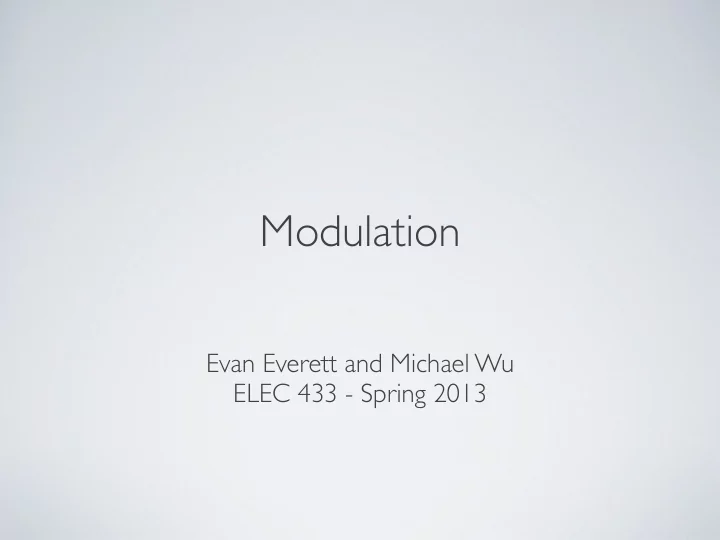

Modulation Evan Everett and Michael Wu ELEC 433 - Spring 2013
Questions from Lab 1?
Modulation Carrier x ( t ) = A sin( ω t + φ ) Data 10100 Modulation • Goal: overlay data onto carrier signal (sinusoid) • Sinusoids have two very accessible parameters • Modulate amplitude and phase
Modulation 1) Interference avoidance Why not? 2) High freq → small antennas Data 10100 Modulation • Goal: overlay data onto carrier signal (sinusoid) • Sinusoids have two very accessible parameters • Modulate amplitude and phase
Signal Representation: Phasor • Polar: Amplitude & Phase • Rectangular: “In-phase” (I) & “Quadrature” (Q) π /2 e d u t i l p m Q A Im[x] Phase π 0 I Re[x] - π /2 x ( t ) = A sin( ω t + φ ) x ( t ) = I cos( ω t ) + Q sin( ω t ) I = A sin( φ ) Q = A cos( φ )
Signal Representation • Rectangular (I,Q) form suggests a practical implementation I Q Im[x] I cos( ω t ) Re[x] 10100 I cos( ω t ) + Q sin( ω t ) 90˚ sin( ω t ) Q • Modulation = mapping data bits to (I,Q) values
Digital Modulation [01] [10] [00] [11] • Maps bits to complex values (I/Q) (focus of the Lab 3) • Complex modulated values are called “symbols” • Set of symbols is called “constellation” or “alphabet” • # of symbols in constellation is “modulation order”, M • M- order constellation can encode ______ bits per symbol
Digital Modulation [01] [10] [00] [11] • Maps bits to complex values (I/Q) (focus of the Lab 2) • Complex modulated values are called “symbols” • Set of symbols is called “constellation” or “alphabet” • # of symbols in constellation is “modulation order”, M • M- order constellation can encode log 2 ( M ) bits per symbol
Phase Shift Keying (PSK) • Encodes information only in phase BPSK ( M =2) QPSK ( M =4) 8-PSK ( M =8) [000] [001] [00] [01] [0] [1] [10] [11] • Constant power envelope • Pros: no need to recover amplitude, no need for linear amplifier • Con: wastes amplitude dimension
Quadrature Amplitude Modulation (QAM) • Encodes information in both amplitude and phase √ √ • (I,Q) grid M × M ∈ 4-QAM 16-QAM 64-QAM • Common in wideband systems: 802.11b 802.11g/n 802.11ac 16-QAM 64-QAM 256-QAM
Bit-to-Symbol Mapping • Confusing with neighbor is most likely error • Best to minimize bit-difference between neighbors • Gray Coding • Neighboring symbols differ by only one bit • Extra performance at zero cost (this is rare!) Natural-coded Gray-coded [01] [10] [01] [11] QPSK QPSK [00] [11] [00] [10]
Tradeoff: Rate vs. Error Probability • By increasing modulation order, M , we get: • More data in same bandwidth :) • Lower noise tolerance (i.e. higher error probability) :( • Therefore, SNR dictates feasible constellation size
QPSK: 2 bits/symbol Q I
QPSK: 2 bits/symbol Q I
16-QAM: 4 bits/symbol Q I
64-QAM: 6 bits/symbol Q I
Bit error rate (BER) vs. SNR per bit (E b /N 0 ) 1E+00 BPSK 1E-01 QPSK 8-PSK 1E-02 16-QAM 1E-03 64-QAM 1E-04 BER 1E-05 1E-06 1E-07 1E-08 1E-09 0 2 4 6 8 10 12 14 16 18 E b /N 0 (dB)
Recommend
More recommend